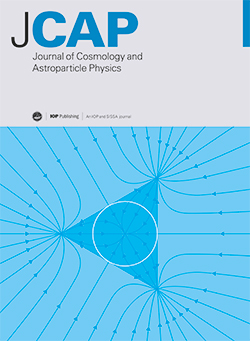关于亚晕中心密度的假设会影响暗物质湮灭和透镜效应的计算吗?
IF 5.9
2区 物理与天体物理
Q1 ASTRONOMY & ASTROPHYSICS
Journal of Cosmology and Astroparticle Physics
Pub Date : 2025-06-23
DOI:10.1088/1475-7516/2025/06/049
引用次数: 0
摘要
亚晕模型在暗物质湮灭预测和星系-星系透镜效应研究中发挥着关键作用;然而,亚晕的内部结构仍然高度不确定。特别是,越来越多的证据表明,在较小的合并中,锯齿状暗物质亚晕的中心密度是保守的,而亚晕演化的经验模型——使用有限分辨率模拟校准——通常假设中心密度下降。为了评估这些假设的影响,我们系统地探索了大范围的初始质量分布和潮汐演化处方如何影响湮灭和透镜计算,包括物理驱动的能量截断模型,该模型明确保留了亚晕的中心密度。我们发现湮灭计算对假设的内部密度分布非常敏感,不同的模型可以在单个亚晕的湮灭速率上产生超过一个数量级的差异,并且在银河系中预期的总湮灭速率中产生约5倍的差异。由于晕的最内部部分在模拟中总是难以解决,我们得出结论,发展对亚晕演化的理论理解对于能够准确预测暗物质湮灭信号至关重要。另一方面,虽然星系-星系透镜中使用的剪切和收敛剖面对假设的初始剖面很敏感(例如,NFW与Einasto),但它们可以通过一个简单的剥离模型很好地近似,其中原始剖面在潮汐半径处被急剧截断。本文章由计算机程序翻译,如有差异,请以英文原文为准。
Do assumptions about the central density of subhaloes affect dark matter annihilation and lensing calculations?
Subhalo models play a critical role in dark matter annihilation predictions and galaxy-galaxy lensing studies; however the internal structure of subhaloes remains highly uncertain. In particular, a growing body of evidence suggests that the central density of cuspy dark matter subhaloes is conserved in minor mergers, whereas empirical models of subhalo evolution — calibrated using limited-resolution simulations — often assume a drop in the central density. To assess the impact of these assumptions, we systematically explore how a wide range of initial mass profiles and tidal evolution prescriptions influence annihilation and lensing calculations, including the physically motivated Energy Truncation model, which explicitly preserves the central density of subhaloes. We find that annihilation calculations are very sensitive to the assumed inner density profile, and different models can produce more than an order of magnitude difference in the annihilation rate of individual subhaloes, and a factor of ∼5 in the total annihilation rate expected in the Milky Way. Since the innermost parts of haloes will always be difficult to resolve in simulations, we conclude that developing a theoretical understanding of subhalo evolution is crucial to be able to make accurate predictions of the dark matter annihilation signal. On the other hand, while the shear and convergence profiles used in galaxy-galaxy lensing are sensitive to the initial profile assumed (e.g., NFW versus Einasto), they are otherwise well-approximated by a simple stripping model in which the original profile is sharply truncated at a tidal radius.
求助全文
通过发布文献求助,成功后即可免费获取论文全文。
去求助
来源期刊

Journal of Cosmology and Astroparticle Physics
地学天文-天文与天体物理
CiteScore
10.20
自引率
23.40%
发文量
632
审稿时长
1 months
期刊介绍:
Journal of Cosmology and Astroparticle Physics (JCAP) encompasses theoretical, observational and experimental areas as well as computation and simulation. The journal covers the latest developments in the theory of all fundamental interactions and their cosmological implications (e.g. M-theory and cosmology, brane cosmology). JCAP''s coverage also includes topics such as formation, dynamics and clustering of galaxies, pre-galactic star formation, x-ray astronomy, radio astronomy, gravitational lensing, active galactic nuclei, intergalactic and interstellar matter.
 求助内容:
求助内容: 应助结果提醒方式:
应助结果提醒方式:


